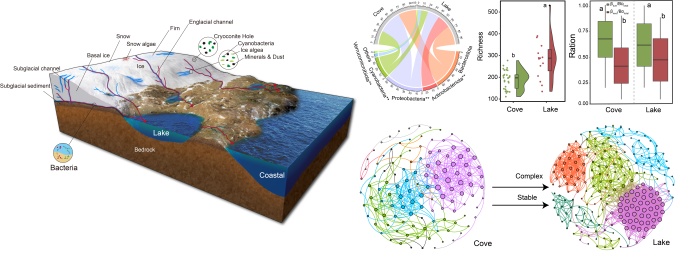
Newsroom
Characteristics of Bacterial Communities in Aquatic Ecosystems Near the Collins Glacial (Fildes Peninsula, Antarctica)
Bacteria are critical for maintaining polar aquatic ecosystem function, and their community composition, indicator species and potential ecological functions can be used to predict changes in aquatic ecosystems. However, there were extremely limited data on the characteristics of bacterial communities in the aquatic ecosystems of the Fildes Peninsula, Antarctica.
The Collins glacier is located in the northern part of the Fildes Peninsula, covering a total area of about 15 km2. A typical sub-Antarctic ecosphere affected by climate change has developed near the Collins glacier. It contains primary development of soils, vegetation, periglacial lakes, and coves affected by glacial meltwater. In the expanding and rapidly changing polar ice-free ecosystems, the differences and hidden linkages of bacteria in different ecosystems, the structure succession and its relationship with ecosystem stability, and the role of bacteria as indicators of hydrological connectivity and heterogeneity are interesting scientific issues in the study of aquatic ecosystems near Collins glacier.
Recently, the research groups led by Prof. BI Yonghong from the Institute of Hydrobiology (IHB) of the Chinese Academy of Sciences and Prof. LUO Wei from the Polar Research Institute of China illustrated the differences and hidden linkages between periglacial lakes and coves near the Collins glacier under summer glacier meltwater injection and glacier retreat from the perspective of bacterial communities. This study was published in Ecological Indicators.
This study analyzed the bacterioplankton and environmental data of five periglacial lakes and two coves in summer obtained from the Great Wall Station of the 34th, 35th and 36th Chinese Antarctic Research Expeditions. Researchers comprehensively explored the diversity, indicator species, and co-occurrence networks of the bacterial communities, revealed the differences and hidden linkages between these two aquatic habitats.
The study found that Proteobacteria, Cyanobacteria, and Bacteroidota were dominant in the bacterial communities of two distinct but associated aquatic habitats. Although two habitats recruited some unique OTUs, they also shared noteworthy proportion of OTUs. Periglacial lakes had higher α diversity. Moreover, the β diversity was mainly caused by turnover.
Based on indicator species and functional prediction analyses, the researchers found that indicator species identified in coves, such as Polaribacter and Sulfitobacter, were predicted more involved in S cycle. Co-occurrence networks showed differences, with the periglacial lakes network being more complex and stable.
These findings confirm that bacterial communities were mainly shaped by ecological niches, and that although the two aquatic habitats are somehow related and had similar influencing factors, each possessed specific indicator species, diversity and co-occurrence networks. This study further deepens our understanding of bacterial community characteristics in the two typical aquatic habitats near the Collins glacier, providing new insights into the impact of glacier retreat on downstream ecosystems.

Diversity of bacterioplankton and stability of their co-occurrence network in two aquatic ecosystems near Collins glacier
(Editor. WANG Hongxia)